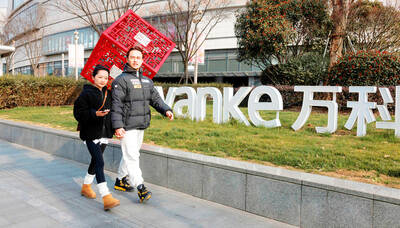Whistling a somber tune as he strides through echoing halls, Richard Chang (
The chief of Semiconductor Manufacturing International Corp (SMIC, 中芯國際集成電路) -- a US$1.5 billion foundry symbolizing China's aspirations to become a global chip powerhouse -- lives in company quarters, sports a cheap digital watch and wears a plain plastic name tag.
Chang's unassuming ways belie the hype surrounding the country's chip sector. China is touted as the market of the future, but many analysts say its chip makers still have a long way to go before they can approach the sophistication of Japan or Taiwan.
"China's market is huge, but regarding profits in this business, there are plenty of uncertainties," Chang said in an interview at his factory in Shanghai's eastern financial district, built on what used to be vegetable farmland.
Since construction of their factories began to much fanfare in 2000, SMIC and cross-town rival Grace Semiconductor Manufacturing Corp (
Industry experts say SMIC and other domestic operators may initially have trouble securing long-term clients used to Taiwan foundries, and that they could incur high labor costs because of a lack of expert local engineers.
"I think they'll rack up incredible losses in DRAM," a senior executive at a China-based chipmaker told reporters. "They're building production lines, but they have no customers."
SMIC, hoping to prove them wrong, aims for monthly capacity of 40,000 wafers by June, from 32,000 now, making it the country's largest operation. That should shoot to 85,000 wafers by next year.
But Taiwan Semiconductor Manufacturing Corp (TSMC,
"Because China has a huge domestic economy, it can sustain growth in chip demand for very long," said Chang, who set up his first foundry in Taiwan in the early 1980s.
Semiconductor demand in China is likely to grow an average of 16 percent a year and hit US$46.7 billion in 2007, technology research group Gartner estimates.
The country, which uses up to 8 percent of the chips made worldwide, imports more than 80 percent of its chips, signalling huge potential for domestic production to replace that.
Experts say there's no denying the promise, but talk about the inflated expectations inherent in China's ambition to mould itself into a global chip powerhouse.
The industry has come a long way.
David Wang (
It really needed just 500 workers, Wang said. The state firm's schools, hospitals and movie theaters employed the rest.
"The quantum leap in the semiconductor industry really happened back in 1999," Wang said.
SMIC has since become a barometer for the burgeoning chip industry. It has forged deals with Germany's Infineon Technologies AG and Japan's Elpida Memory Inc, and is gunning for a listing sometime late this year or early next year.
"A listing this year might be challenging," Chang conceded.
SMIC has not disclosed its shareholder structure, but Taiwanese investors are believed to hold a significant stake.
It also has financial backing from Goldman Sachs and Shanghai Industrial Holdings.
Now for the bad news. China still lacks many elements essential elements to drive its chip industry -- mass capacity, a viable design industry and a critical mass of the companies that supply the equipment to convert the silicon wafers into chips.
Without those suppliers, global giants like Intel Corp are unlikely to start making chips there.
Most domestic players now make simple chips for appliances and remote controls.
But things could change. TSMC is seeking final approval to set up a US$900-million plant in China, which would be a milestone for the country's chip industry.
"We believe that by 2006, 2008, China will play a significant role on a worldwide basis," said Edward Braun, chief of US chip equipment maker Veeco Instruments Inc.
"We're in the first or second year of a 10-year development cycle," he said. "We need to be patient and allow growth."
Chang says there is another daunting challenge.
"Inertia in government is huge. It's hard to get it moving," said Chang, former boss of Worldwide Semiconductor Manufacturing Corp (
"Top leaders are clear what needs to be done, but a lot of lower officials haven't caught up yet," he said.

CHIP RACE: Three years of overbroad export controls drove foreign competitors to pursue their own AI chips, and ‘cost US taxpayers billions of dollars,’ Nvidia said China has figured out the US strategy for allowing it to buy Nvidia Corp’s H200s and is rejecting the artificial intelligence (AI) chip in favor of domestically developed semiconductors, White House AI adviser David Sacks said, citing news reports. US President Donald Trump on Monday said that he would allow shipments of Nvidia’s H200 chips to China, part of an administration effort backed by Sacks to challenge Chinese tech champions such as Huawei Technologies Co (華為) by bringing US competition to their home market. On Friday, Sacks signaled that he was uncertain about whether that approach would work. “They’re rejecting our chips,” Sacks

Taiwan’s long-term economic competitiveness will hinge not only on national champions like Taiwan Semiconductor Manufacturing Co. (TSMC, 台積電) but also on the widespread adoption of artificial intelligence (AI) and other emerging technologies, a US-based scholar has said. At a lecture in Taipei on Tuesday, Jeffrey Ding, assistant professor of political science at the George Washington University and author of "Technology and the Rise of Great Powers," argued that historical experience shows that general-purpose technologies (GPTs) — such as electricity, computers and now AI — shape long-term economic advantages through their diffusion across the broader economy. "What really matters is not who pioneers

BUBBLE? Only a handful of companies are seeing rapid revenue growth and higher valuations, and it is not enough to call the AI trend a transformation, an analyst said Artificial intelligence (AI) is entering a more challenging phase next year as companies move beyond experimentation and begin demanding clear financial returns from a technology that has delivered big gains to only a small group of early adopters, PricewaterhouseCoopers (PwC) Taiwan said yesterday. Most organizations have been able to justify AI investments through cost recovery or modest efficiency gains, but few have achieved meaningful revenue growth or long-term competitive advantage, the consultancy said in its 2026 AI Business Predictions report. This growing performance gap is forcing executives to reconsider how AI is deployed across their organizations, it said. “Many companies

China Vanke Co (萬科), China’s last major developer to have so far avoided default amid an unprecedented property crisis, has been left with little time to keep debt failure at bay after creditors spurned its proposal to push back a looming bond payment. Once China’s biggest homebuilder by sales, Vanke failed to obtain sufficient support for its plan to delay paying the 2 billion yuan (US$283.51 million) note due today, a filing to the National Association of Financial Market Institutional Investors showed late on Saturday. The proposal, along with two others on the ballot, would have allowed a one-year extension. All three